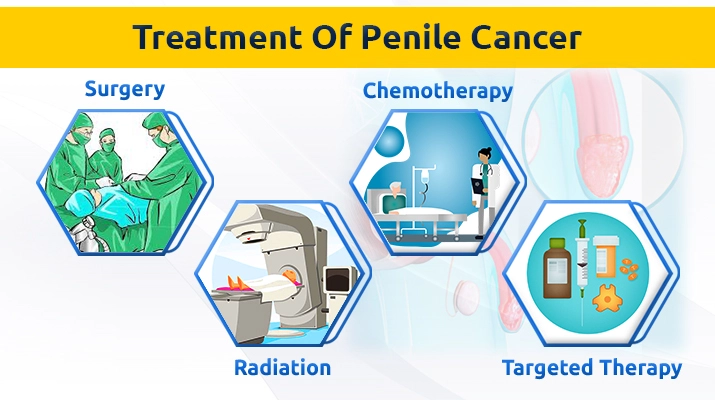



Penile cancer or cancer of the penis is when cells grow out of control in a man's penis. It often starts in skin cells and can work its way inside. Penile cancer is a relatively rare form of cancer that affects the skin and tissues of the penis. It occurs when normally healthy cells in the penis become cancerous and begin to grow out of control, forming a rare tumour. But it can be treated, especially if it's found early on.
The first noticeable symptom of penile cancer is typically a lump or ulcer on the penis. It may look like an untrusted Source like a small, insignificant bump or a large, infected sore. In most cases, it'll be located on the head or foreskin instead of on the shaft of the penis.
Epidermoid carcinoma - This makes up 95% of penile cancer cases. It usually starts on or under your foreskin but can also appear on other parts of your penis.
Sarcoma - These cancers form in tissues like blood vessels, muscles, and fat.
Melanoma - This is cancer that starts in the cells that give your skin colour.
Basal cell carcinoma - These cancers start deep in your skin. They grow slowly and aren't likely to spread to other areas of your body.

Cancer on the penis can look like a lump, mass, sore, or discolouration, depending on the type of skin cancer that's causing it. It's most commonly located on the foreskin or the head of the penis.
A urologist can perform diagnostic tests to determine whether the lump is cancerous.
People with uncircumcised penises are more likely to Trusted Sources to develop penile cancer. This may be because people with uncircumcised penises are at risk of other conditions that affect the penis, such as phimosis and smegma.
Phimosis is a condition in which the foreskin becomes tight and difficult to retract. People with phimosis have a high risk of developing smegma.
Smegma is a substance that forms when dead skin cells, moisture, and oil collect underneath the foreskin. It may also develop if the area under the foreskin is not cleaned properly, which can cause inflammation.
[elementor-template id="1379"]
A doctor can make a penile cancer diagnosis by performing certain diagnostic tests, including:
Physical examination - During a physical exam, a doctor will look at your penis and inspect any lumps, masses, or sores that are present.
Biopsy - A biopsy involves the removal of a small sample of skin or tissue from the penis. The sample is then analyzed to determine whether cancer cells are present.
MRI - An MRI of the penis is sometimes conducted to make sure that cancer hasn't spread to the deeper tissues of the penis.
CT Scan - A CT or CAT scan makes detailed images of the body from different angles. Sometimes, dye is injected or swallowed to help a doctor see certain areas more clearly.
PET Scan - This test uses a small amount of injectable radioactive glucose to find cancerous tumour cells in the body. Cancer cells show up brighter on this imaging test since they use more glucose. A PET scan may be performed with a CT scan.
Cystoscopy - During a cystoscopy, a doctor will gently insert a thin tube with a camera on the end into the penis opening and through the bladder. This allows them to view the different areas of the penis and the surrounding structures.
Ultrasound - This tests high-energy energy sound waves to form a picture of body tissues.
The staff cancer describes how far it has spread. Based on the results of the diagnostic tests, a doctor will determine which stage the cancer is currently in.
Cancer is only on the top layer of the skin. Cancer hasn't to spread any glands, lymph nodes, or other parts of the body.
Cancer has spread into the connective tissue just below the skin. Cancer hasn't spread to any lands or any other parts of the body.
Cancer has spread to the connective tissue below the skin to lymph vessels or blood vessels, or cells look very different from normal cells, or cancer has spread to erectile tissues or the urethra. Cancer hasn't spread to any other parts of the body.
Cancer has spread to one or two lymph nodes on the same side of the groin. Cancer hasn't spread to any other parts of the body.
Cancer has spread to the connective tissues. Below the skin and lymph vessels. Cells look very different from normal cells, or cancer has spread to erectile tissues or the urethra. Cancer has spread to three or more lymph nodes on one side of the groin or multiple lymph nodes on both sides of the groin. Cancer hasn't spread to any other parts of the body.
Cancer has spread to nearby areas, such as the pubic bone, or scrotum, or cancer has spread to other areas and organs of the body.
It's important to have a strong support network that can help you deal with any anxiety or stress you may be feeling. You may also want to consider joining a cancer support group to discuss your concerns with others who can relate to what you're going through.